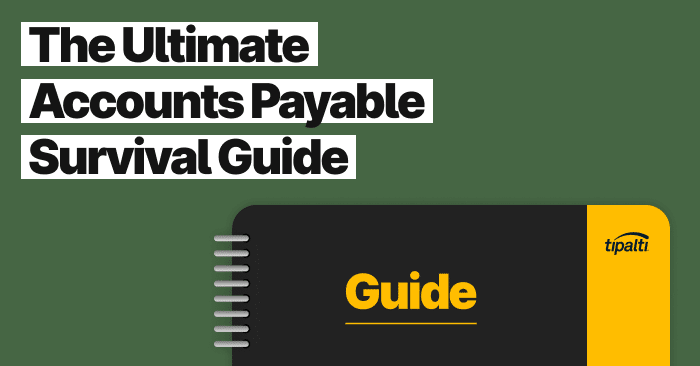
See how forward-thinking finance teams are future-proofing their organizations through AP automation.
Fill out the form to get your free eBook.

Today, the finance function has more responsibilities than ever. In high-growth businesses, every operation—both front and back-office—is inexplicably tied to investment versus reward. To survive the uncharted road ahead, the modern, forward-thinking finance team has to future-proof their organization for success. Download the guide to discover: – The untamed wilderness of finance – How to forge an accounts payable path – How to strategize your next move – The ultimate accounts payable survival tool – How real-life survivalists scaled their businesses
Have you had enough of dealing with heaps of costly paper invoices for your organisation? Welcome to the era of e-invoicing that can speed up your processes and cut costs.
Find out what the UK regulations on e-invoicing are and what tools you can use to optimise your business processes.
We will pay specific attention to how e-invoicing works, outline the process, discuss typical problems with paper invoicing, and describe automated e-invoicing solutions relevant to UK businesses, including compliance with HMRC, to help you prepare practically for e-invoicing and comply with all regulations.
What is E-invoicing?
E-invoicing, or electronic format invoicing, involves the automatic sending of standardised invoice data between trading partners from the supplier’s system to the customer’s system.
It can automate accounts payable functions, significantly boosting efficiency. With compatible standardisation, cross-border transactions can work seamlessly with e-invoicing and subsequent global mass payments.
AP functions include receiving and processing vendor invoices related to procurement, three-way matching to supporting documents including purchase orders and receiving reports, obtaining approvals, making supplier payments, and generating payables aging and payments reports.
How Do Businesses Create an Electronic Invoice?
Vendors create electronic invoices (e-invoices) that are sent directly to their customers’ software systems for payment using the invoicing features of their ERP or accounting systems, like QuickBooks. Some payment apps or add-ons include e-invoicing with pay now buttons.
If customers receive paper invoices, they can digitise them using advanced OCR software that may be part of or an add-on to AP automation software integrated with ERP or accounting systems. Scanning and converting paper invoices received to electronic format invoices may not be considered e-invoicing because the customer’s business takes intervening steps to get the invoices into its system.
What Manual Invoicing Problems Does E-Invoicing Solve?
If a company’s AP staff or finance departments operate manually, here are some of the deepest cash flow and resource gouges it can (and should) expect:
- Incorrect data entry from human error.
- Lost time and company resources due to fixing those errors.
- Wasted time and human productivity from manual invoice approval.
- Duplicate manual entries leading to duplicate payments.
- Dramatically heightened risk of fraudulent invoices.
It’s common to see AP staff using OCR software in a non-automated environment to quickly transcribe and record physically mailed invoices or emailed PDF invoices.
Once the software records the invoices, an employee has to manually verify the information, resulting in as much wasted time and resources as with a fully manual process operation. While e-invoicing also makes use of OCR, it does so in a fully automated manner. Adopting structured data formats like XML and EDI can further reduce errors and streamline processes.
What are E-Invoicing Solutions?
E-invoicing software is a solution for operating in the world of AP. Its distinguishing factors are its use of compatible supplier systems to customer system data standards and possibly field mapping for interoperability and strategic centrality. All key data related to invoicing is sent to a centrally accessible cloud storage database, which supports better transaction controls.
E-invoicing supports AP automation to streamline workflows in real-time, including supplier portal integration and document storage, automated invoice matching and approvals, global mass payments processing and automatic reconciliation, and robotic process automation (RPA) of routine tasks. These automated solutions are benefits of e-invoicing.
(If e-invoicing isn’t used, suppliers can also upload their electronic format invoices into a customer’s integrated supplier portal for centralised vendor management, status, and payment by the customer.)
This means that multiple individuals from different departments can access the same body of general info but pull the individual bits and pieces from it that are relevant to their department and its operations. E-invoice processing totally eliminates the time and resource burden of employees running between departments daily to cross-check their info, verify approval, and so on. The total annual resource savings in terms of actual employee productivity from this aspect alone are considerable.
Fraud prevention is another benefit of invoice automation combined with e-invoicing generating massive year-over-year savings for a business. Here’s the thing about fraudulent invoices…it only takes the fraudster one successful attempt on average to establish a deceptive (but lucrative) tie to a company’s AP department. Manual AP staff lack a centralised list of pre-approved and verified vendors.
So when a fraudulent invoice comes through, the odds of it “falling through the cracks” and getting paid are extremely high. And what do companies tend to do with their suppliers? Keep paying them with each monthly invoice, of course. After all, they provide a highly valuable service to the business.
The short—and long-term problems here should be glaringly apparent. But invoice automation can hugely alleviate these risks. E-invoicing solutions allow a business to set up a verified list of approved suppliers and instantly check each invoice against that list.
An invoice from a supplier not present on the list will immediately be flagged for further inspection and possible fraud so that it can be traced and verified. Using digital signatures can further enhance security and ensure authenticity.
Ready to maximise efficiency with automated invoice management?
Simplify invoicing, ensure compliance, and reduce errors with Tipalti’s e-invoicing solution. Automate AP and VAT reporting effortlessly.
UK E-Invoicing: Key Considerations
E-invoicing regulations are slightly different across jurisdictions, and the UK is at the forefront of moving businesses into a digital-first world, where e-invoicing is increasingly becoming the norm for many businesses.
Current Regulatory Landscape in the UK
While e-invoicing mandates are currently voluntary for most business-to-business transactions in the UK, they are compulsory for transactions with UK public sector entities (e.g., NHS, government departments).
Suppliers must use the PEPPOL network (Pan-European Public Procurement Online) and adhere to structured formats like XML or UBL to ensure interoperability. For example, NHS suppliers need PEPPOL access points and product codes (GLN/GTIN) for compliance.
For UK businesses, becoming PEPPOL-compliant means using platforms that integrate with a certified PEPPOL Access Point Provider (PAP). Tipalti supports e-invoicing workflows and compliance by integrating with trusted third-party providers to enable secure exchange of e-invoices through the PEPPOL network.
Private businesses that adopt e-invoicing voluntarily must meet HMRC’s authenticity, integrity, and legibility standards.
Technical and VAT Compliance
Structured data (XML, EDI) or unstructured (PDF) formats are allowed, provided they are readable. Authentication is achieved via certified digital signatures, EDI systems, or audit trails.
Businesses cannot issue both paper and e-invoices for the same customer/supply chain, except during testing. E-invoices must include the same details as paper invoices (e.g., VAT number, invoice date, supply details) and be stored for 6 years in a tamper-proof archiving format.
HMRC mandates that all e-invoices, like their paper counterparts, must include essential details such as the supplier’s VAT number, invoice date, a detailed description of the goods or services provided, and the total amount due, inclusive of VAT. E-invoices must be securely stored for a minimum of six years to comply with HMRC’s record-keeping requirements.
Making Tax Digital
E-Invoicing aligns with the Making Tax Digital (MTD) initiatives for digital VAT reporting. This approach is critical for ensuring ongoing tax compliance. Businesses should also ensure their e-invoicing solution provides audit trails to demonstrate compliance with VAT regulations.
Getting Started with E-Invoicing in the UK: A Practical Guide
For UK businesses looking to embrace e-invoicing, here’s a step-by-step guide:
- Assessment: Evaluate your current invoicing processes to identify pain points and areas for improvement. How much time is spent on manual data entry? What are the costs associated with paper invoicing?
- Solution Selection: Research and compare e-invoicing solutions, considering your business size, industry, existing systems, and budget. There is a diverse marketplace in the UK, catering to various budgets and the complexity of invoicing requirements. From cloud-based platforms to more bespoke systems, a business should conduct thorough research.
- Integration: Ensure the chosen solution integrates seamlessly with your existing accounting software (e.g., Sage, Xero, QuickBooks) and ERP systems.
- Staff Training: Provide comprehensive training to your staff on how to use the new e-invoicing system.
- Pilot Program: Start with a small pilot program involving a select group of suppliers and customers to test the system and identify any issues.
- Rollout: Gradually roll out e-invoicing to the rest of your suppliers and customers.
- Monitoring: Continuously monitor the performance of the e-invoicing system and make adjustments as needed.
Selecting the Right E-Invoicing Platform: Key Considerations for UK Businesses
- Compliance: Does the platform comply with HMRC regulations and PEPPOL standards?
- Integration: Does it integrate with your existing accounting and ERP systems?
- Scalability: Can it scale to meet your growing business needs?
- Security: Does it provide adequate security to protect your financial data?
- User-Friendliness: Is it easy to use for both your staff and your suppliers?
- Cost: What is the total cost of ownership, including software fees, implementation costs, and training costs?
An important aspect to consider is supplier onboarding. Will suppliers need to pay in order to utilise a selected system? It’s important to streamline this process as much as possible.
Summing Up
UK tax authorities are increasingly focused on digital solutions, making e-invoicing compliance a critical aspect of business operations. By embracing these initiatives, businesses can thrive in the digital age.
HMRC’s website provides extensive guidance on e-invoicing, including VAT obligations, record-keeping requirements, and approved methods for digital signatures and authentication.
Need an e-invoicing solution? Tipalti’s e-invoicing solution automates invoice processing, streamlines accounts payable, and keeps you compliant worldwide. Request a demo today.
